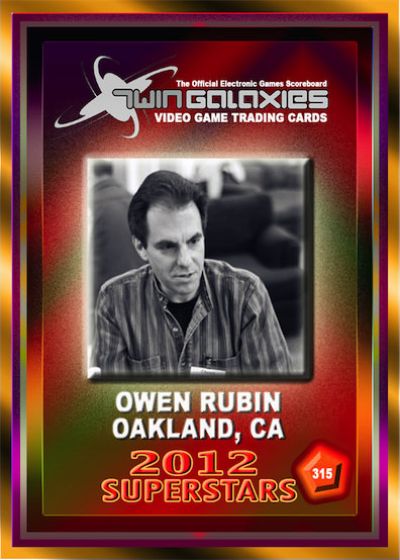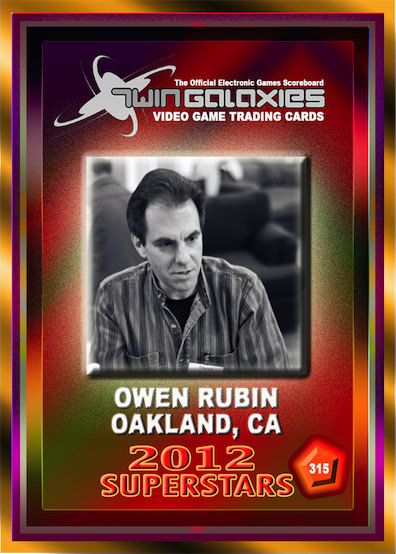- Home
- Articles
- Trading Card Spotlight
- Trading Card Spotlight - Owen Rubin
Trading Card Spotlight - Owen Rubin
Our next Trading Card Spotlight features Owen Rubin, who currently is displayed on card number 315, from the Superstars of 2012 Collection. Owen was one of the first programmers hired by Atari in 1976. He designed games for Atari for almost 9 years. His most successful games were Space Duel and Major Havoc. Later in his career he joined up with Interactive Productions, where he designed the first cross multi-platform game system for AOL. Owen was Co-founder of Innovative Leisure, a game start up company made up of early arcade veterans, and now works at Apple.
Do you remember when you played your “video game” and what do you remember about the experience?
My very first video game was Computer Space. I loved it. I would still like to own one!
What are your opinions about today’s generation of video games? How do you compare them to older, classic games?
There are some amazing quality games out there, but I do not like all the violence and killing. I truly think it desensitizes kids to violence, killing, breaking the law, ... I think Mortal Combat started this graphic violence style game, and I do not like them much. I’m not a prude, but I think it unnecessary to graphically kill someone in a game.
Many rely way too much on graphics and skimp on game challenge and play or become repetitive too quickly. So, I mostly play games on my phone, as it kind of feels like an arcade game in many ways.
I think older games put more into quickly getting to something fun as game play was key because we didn’t have super high graphics or multi-million-dollar budgets.
Did you ever think when you were younger you would be on a video game trading card?
It makes me smile. I never imagined there would still be interest in what we did so many years ago. It’s fun.
What is the great memory that happened at Atari that most people would not know?
Well, there is probably a reason it’s not known. :-) For me, I had only been at Atari for maybe a month. I was in a smaller building behind the engineering building. The team I joined was working on 8 player color tank, among other things, and the original prototype had an attract mode where all 8 tanks would battle it out. There was a lot of random in the computer play, and the attract would play until one tank won. I came back from lunch early one day and sitting around the game were 4 to 6 or so men in business clothing. They were betting on the attract mode, picking one or two tank colors, and plopping money on the screen, and then cheering on their pick.
After they were done,one man stayed behind and was studying the attract play. I sat down across from him and we started talking about game play, and what I liked and did not like at Atari. A very candid conversation. When he finally left, my boss walked up to me and said, “Well, nice knowing you!” Huh? Turns out it was Nolan Bushnell, and there I was airing things that were not working well. Nolan some short time later asked me to lunch, and we became friends. He always said he liked my honesty.
What is your favorite project that you have worked on in your career?
Well, Major Havoc has to be up there. Loved making that game. Being a designer on the first commercially viable broadband system in the US is also quite high on my list. And being at Apple the first time and being part of the design team for the first low-cost color Mac.
How did you get your first job at Atari and how old were you?
I was a senior in college (Univ of CA at Berkeley), so what, 21 or 22 years old. I heard they were interviewing on campus and got a spot. They returned me down. I got a letter that I was not the kind of hardware engineer they were looking for. Well maybe because I thought I was interviewing for a software game designer. So, I called Atari and spoke with the engineering VP. I explained what I thought I was looking for, he read over my resume and the interview notes, and invited me down to Campbell to talk about it. I met three or four people and was hired on the spot. A lucky break.
What made you want to get into the gaming business?
I had always loved pinball and electromechanical arcade games growing up as a kid. My dad used to take my brother and me to the train station where they had 6 to 10 games. Or to the arcades at the boardwalk in San Francisco. I built my own home computer (an Imsai 8080 clone) and was always building and playing with electronics since a little kid. In college, I took a computer I/O class where we were supposed to draw something simple on an oscilloscope. I made a pong game. Yea, it was a good move.
What is your favorite portable gaming device and why?
My iPhone. There are so many games of every genre and the cost is reasonable. And like I said before, it kind of feels like arcade games.
Do you prefer arcade or console gaming and why?
My last console I purchased was a N64. I liked those games, especially Mario Cart and Zelda. But I spent waaaaayyyyy to much time playing it. So, I have not bought one since. An incredible time suck machine and I know I would get sucked in to sone games. So no, I don’t buy them. So, phone and iPad games, and my love for arcade games of course.
What was your fondest memory at Interactive Productions?
Working for Rob Fullop was a blast, and he had a great team there. Designing a system to play interactive NETWORKED games for Quantum Link (which became AOL) at that time was groundbreaking. Games could play between players on a C-64, Apple II, Macintosh, and a PC all over the US together. We ported Rob’s Rabbit Jack’s Casino game to the system.
When you worked for Apple, what was your first impression and why?
Well, I had an original Mac, and was hooked immediately. I started in the Apple IIgs system group and then moved to the Mac group to work on the color Mac. It was a lot more organized than Atari or Interactive Prod., but a great education as well.
What games today do you play and what are your favorite genres of games?
I don’t really know. I just grab games on the phone because someone suggested it. I like card and casino games, driving games, puzzle games, and “endless runner” games, which feel very arcade like.
What does it take to get a career in video game programming, and what advice would you give a person today who would like to get into the industry?
I have no idea these days, it’s a very different industry. I suspect being a really good programmer. Excellent in C++ and similar obj oriented languages. A solid knowledge of 3D systems and math. Understanding of the AR and VR space or know how to program a console.
Do you believe some video games are too violent and lead to violence in America today?
Yes to both questions. There are studies that have proven a correlation between violent video games and a desensitized nature towards violence.
Which company today, in your opinion, makes the best games and why?
I really have no idea since I don’t really play them. I suspect Nintendo ranks high as I would expect does EA. But some of the indie games I’ve seen are damn good.
Do you like it when Hollywood makes a movie from the video game?
Yes, and no. Ready Player One was a great book. The movie was awful. I’m hard pressed to find a movie from a video game that was a total blockbuster.
I’ve not seen Mortal Kombat, for what should now be obvious reasons. Nor Resident Evil. Tomb Raider was OK. I just looked at the top 20 movies from games list. I think 16 are blood and gore and killing games/movies. No thanks.
How long did it take to design the first multi-player game system for Quantum Link (AOL)?
A little over 6 months to the first prototype.
Who is your favorite video game character of all time and what makes that character special?
Well, Major Havoc. First game character to have idle animations. One of the first video game characters to have a back story. He does not carry a gun!
Are you still involved in any way with video games today, and if so, what role do you play?
I can’t discuss what I do these days. I work for Apple again, and we do not discuss things not released. But I did work on SwiftStrike shown at WWDC 2019, and BugBreakAR for WWDC 2020.
Where do you see video gaming in the next 20 years?
No clue. I’m sure, if the direction continues, more violence in games, an increase in immersive technology like AR and VR gaming. More amazingly powerful consoles that will have photo-realistic graphics and smart AI characters. Games that will rival movies and TV.


